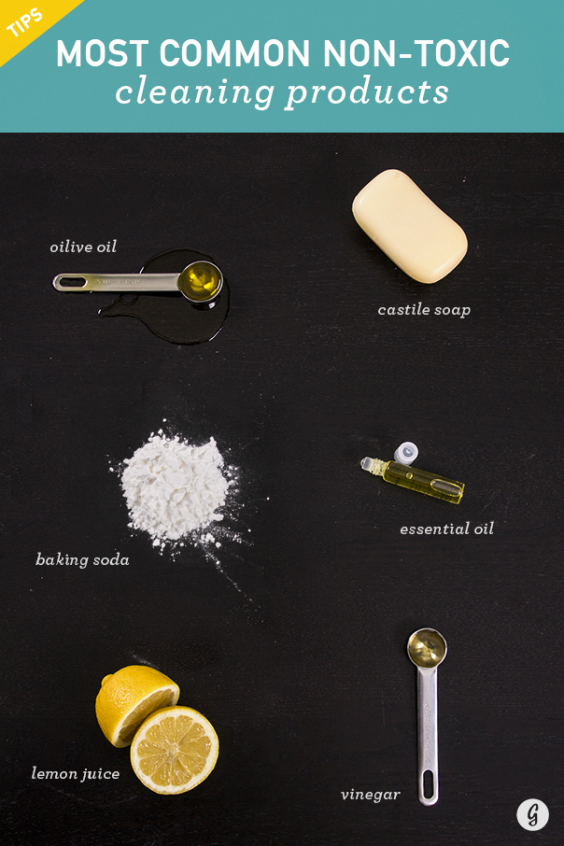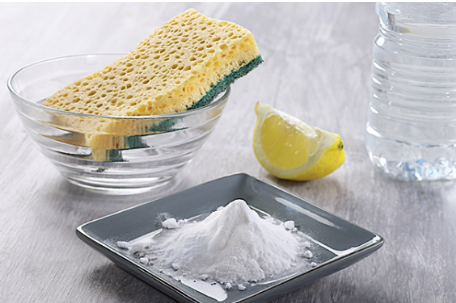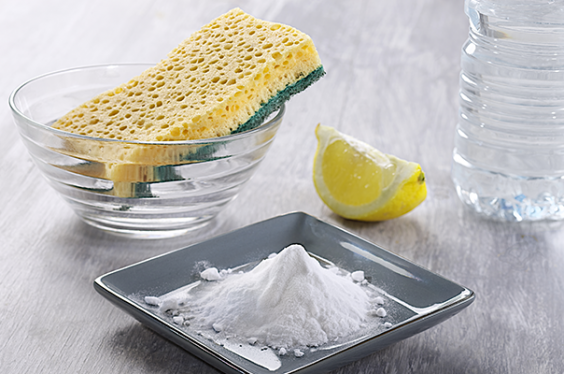27 Chemical-Free Recipes for DIY Spring Cleaning
Non-toxic homemade cleaning products aren’t just better for us; they can also help save us money and protect the environment.
Spring is finally here (please?), and that means it’s time for lounging in the grass, tossin’ the disc, barbecuing with friends, and scouring your living space from top to bottom.
While it might be tempting to spray your whole place with bleach (that makes things “clean,” right?), a lot of common household cleaning products are actually pretty toxic to our health. Luckily, there are alternative ways to keep things fresh and sanitary. Read on for the low-down on cleaning every area of the home, DIY style.
Ditching the Dirt—The Need-to-Know
The Environmental Protection Agency ranks indoor air pollution among the top environmental dangers, and much of this pollution comes from common cleaning products (or what we’ll call “indoor pollutants”). Immediate effects of exposure to indoor pollutants can include headaches, dizziness, fatigue, and irritation of the eyes, nose, and throat, as well as exacerbated symptoms of asthma and other respiratory illnesses. Long-term effects (following long or repeated exposure to indoor pollutants) include respiratory diseases, heart disease, and even cancer. The indoor pollutants that can cause these reactions are so common that the EPA strongly recommends everyone improve the air quality of their home, regardless of whether symptoms are currently present. In other words, these pollutants are pretty whack.
Despite the consequences of exposure to indoor air pollutants, the government doesn’t regulate or assess the safety (or even labeling) of the vast majority of cleaning products on the market. The EPA, meanwhile, only regulates cleaners that contain registered pesticides. This means that consumers are basically on their own when it comes to choosing safe cleaning products—a task that’s way easier said than done. (For reviews of the toxicity of 200 hundred household cleaners, check out the Environmental Working Group’s database.).
Luckily, chemical-laden cleaning products aren’t the only means to keep a home sparkly. Non-toxic homemade cleaning products aren’t only better for us; they can also help save us money and protect the environment. Making your own products cuts down on packaging waste and reduces the release of household chemicals that can contribute to air and water pollution. The best news? The majority of the most powerful cleaning products may well already be on our pantry shelves.
So Fresh and So Clean—Meet the Star Players
Before we get to the cleaning, let’s check out some of the most common (and most useful) non-toxic cleaning products.
Baking Soda
Baking soda is a pantry staple with proven virus-killing abilities that also effectively cleans, deodorizes, brightens, and cuts through grease and grime .
Castile Soap
Castile soap is a style of soap that’s made from 100 percent plant oils (meaning it uses no animal products or chemical detergents). Popularized by the Dr. Bronner’s line of products, castile cuts through grease and cleans.
Vinegar
Thanks to its acidity, vinegar is nothing short of a cleaning wunderkind—it effectively (and gently!) eliminates grease, soap scum, and grime.
Lemon Juice
Natural lemon juice annihilates mildew and mold, cuts through grease, and shines hard surfaces (It also smells awesome.).
Olive Oil
This good-for-you cooking oil also works as a cleanerand polisher.
Essential Oils
Essential oils have gained popularity thanks to aromatherapy, but these naturally occurring plant compounds also make great scent additions to homemade cleaning products (particularly if you’re not into the smell of vinegar). Essential oils are generally considered safe, but these extracts can trigger allergies—so keep this in mind when choosing scents.
Borax
Many DIY cleaners tout Borax (a boron mineral and salt) as a non-toxic alternative to mainstream cleaning products; however, the issue is pretty hotly debated. Some research suggests Borax can act as a skin and eye irritant and that it disrupts hormones. For this list, we’ve chosen to avoid products that use Borax.

A note on mixing products: Most of these ingredients can be used in combination with each other; however, many sources advise against mixing castile soap with vinegar or lemon juice. Since castile soap is basic (i.e., high on the pH scale) and vinegar and lemons are acidic, the products basically cancel each other out when used in combination (though it’s fine to wash with a base—like castille soap—and rinse with an acid—like vinegar!).
Cleaning Recipes for Every Surface
Note: Many of these cleaners can be used in multiple places, but we've assigned them to particular areas for easy reference.
Bathroom
1. Toilets
For a heavy-duty toilet scrub that deodorizes while it cleans, pour ½ cup of baking soda and about 10 drops of tea tree essential oil into the toilet. Add ¼ cup of vinegar to the bowl and scrub away while the mixture fizzes.
For daily cleaning, fill a small spray bottle with vinegar (about 1 cup should do it) and a few drops of an essential oil of your choosing (lemon and tea tree both work well). Spray on the toilet seats, let it sit for a few minutes, and then wipe the surface clean.
2. Tub and Shower
Tubs and showers can produce some of the toughest grime, but it’s no match for the cleaning power of vinegar. To get rid of mildew, spray pure white vinegar on the offending area, let it sit for at least 30 minutes, and then rinse with warm water (don’t be afraid to use a sponge if rinsing doesn’t clear away the grossness on its own). Alternatively, try mixing together baking soda with a bit of liquid castile soap, then scrub and rinse.
For daily cleaning or to get rid of soap scum, mix 1 part water with 1 part vinegar (and a few drops of essential oils if you’re not into the smell of vinegar) in a spray bottle. Spray, let it sit for at least several minutes, and then wipe away.
3. Disinfectant
Skip the bleach and make a homemade germ-killerinstead. Just mix 2 cups of water, 3 tablespoons of liquid soap, and 20-30 drops of tea tree oil. Voila!
4. Air Freshener
Defeat less-visible bathroom “uncleanliness” with this homemade, non-toxic air freshener. All you need is baking soda, your favorite essential oil, and an old jar with a lid you don’t mind poking holes in (follow the link for full instructions).
5. Hand Soap
Once you’re done cleaning the bathroom, it’s time to make yourself clean (or at least your hands). To make a non-toxic, foaming hand soap, mix together liquid castile soap and water (and an essential oil if you feel like it) in a foaming soap dispenser. Fill about one fifth of the bottle with soap, then top it off with water.
Kitchen
6. Countertops
For a simple, all-purpose counter cleaner, mix together equal parts vinegar and water in a spray bottle. If your countertop is made from marble, granite, or stone, skip the vinegar (its acidity is no good for these surfaces) and use rubbing alcohol or the wondrous power of vodka instead.
7. Cutting Boards
Talk about non-toxic: All that’s needed to clean and sanitize cutting boards (wood or plastic) is… a lemon! Cut it in half, run it over the surfaces, let sit for ten minutes, and then rinse away. If you need some serious scrubbing power, sprinkle some coarse or Kosher salt over the board, and then rub with ½ a lemon.
8. Oven
To clean stubborn, caked-on food out of the oven, just heat the over to 125 degrees and grab your spray bottle of vinegar (see “countertops” above). Once the oven is warm, spray the caked-on stuff until it’s lightly damp and then pour salt directly onto the affected areas. Turn off the oven, let it cool, and then use a wet towel to scrub away at the mess. If that doesn’t cut it, follow the same instructions but try use baking soda in place of salt (just let it sit for a few minutes before scrubbing).
9. Garbage Disposal
This one is so cool. Pour 1 cup of vinegar into an ice cube tray and top off the slots with water. Once they’re frozen, toss a few down the disposal and let it run—doing so should remove any food that was stuck to the blades.
10. Microwave
It’s easy to overlook the microwave while cleaning, but man can it get gross in there. To combat the gunk, pour some vinegar into a small cup and mix in a little lemon juice (exact amounts don’t really matter). Put the cup in the microwave, let the microwave run for 2 minutes, and leave the door closed for several more minutes. Finally, open the door and simply wipe down all the sides with a warm cloth or sponge—no scrubbing required!
11. Sink Drain
To unclog a stuffed-up drain, start by boiling about 2 cups of water. Pour ½ cup of baking soda into the drain, and then add the water while it’s still nice and hot. If that doesn’t do the trick, follow the baking soda with ½ cup of vinegar, cover it up tightly (a pot lid should work nicely), wait until the fizzing slows down (when baking soda and vinegar come in contact, they’ll react by fizzing) and then add one gallon of boiling water.
12. Pan De-Greaser
To cut through the grime on frying pans, simply apply some salt (no water necessary) and scrub vigorously.
13. Cast-Iron Pans
Kitchen professionals are pretty against using soap, steel wool, or dishwashers to clean cast-iron pans. Luckily, there’s an alternative way to tackle cast-iron grossness: combine olive oil and a teaspoon of coarse salt in the pan. Scrub with a stiff brush, rinse with hot water, and you’re done!
14. Dishwasher Detergent
If you’re lucky enough to have a dishwasher, simply mix together 1 cup of liquid castile soap and 1 cup of water (2 teaspoons of lemon juice optional) in a quart-size glass jar. Add some of this mixture to one detergent compartment of the dishwasher, and fill the other compartment with white vinegar.
15. Dish Soap
If washing dishes by hand, simply combine 1 cup of liquid castile soap and 3 tablespoons water (a few drops of essential oil optional) in a bottle of your choice. Shake well and use like you would any other dish soap.
16. Refrigerator Cleaner
To clean what is perhaps the toughest of all kitchen “gross spots,” reach for the baking soda. Add about ½ cup of the white stuff to a bucket of hot water. Dip a clean rag in the mixture and use it to wipe down the fridge’s insides.
17. Bleach
For serious disinfectant power, mix ½ cup baking soda, 1 teaspoon castile soap, and ½ teaspoon hydrogen peroxide. Use a cloth to apply the mixture to a wet surface, scrub, and then rinse thoroughly.
Laundry Room
18. Laundry Detergent
It’s tough to come by homemade laundry detergents that don’t use Borax, but give this one a try. The recipe calls for glycerin soap, washing soda, baking soda, citric acid, and coarse salt. For full instructions, follow the link!
19. Fabric Softener
Skip the liquid fabric softener and make clothes nice and snuggly the non-toxic way. Make a big batch of softener by adding 20-30 drops of the essential oil of your choice to a one-gallon jug of white vinegar. Add 1/3 cup to each laundry load (just be sure to shake the mixture prior to each use).
20. Laundry “Scenter”
To add a fresh, clean scent to laundry, make a sachetstuffed with your favorite dried herbs (lavender, peppermint, and lemon verbena are all great options). Toss it in the dryer while it’s in use, and voila: customized, non-toxic scent!
21. Bleach
For a nontoxic laundry bleach alternative, add some lemon juice to the rinse cycle.
Everything Else
22. Floors
For a simple, effective tile floor cleaner, simply combine one part white vinegar with two parts warm water in a bucket. Use a mop or rag to scrub down the floors with the solution. No need to rinse off! (Note: this one’s not recommended for wood floors).
23. Walls
To scrub down walls, mix ¼ cup white vinegar with 1 quart warm water, then use a rag to scrub those walls down. To remove black marks, simply scrub at the spot with a little bit of baking soda.
24. Windows and Mirrors
For an all-purpose window cleaner, combine 1 part white vinegar with 4 parts water (feel free to add some lemon juice if you’re feeling citrusy), then use a sponge or rag to scrub away.
25. Furniture Polish
For an all-purpose furniture polish, combine ¼ cup vinegar with ¾ cup olive oil and use a soft cloth to distribute the mixture over furniture. For wood furniture (or as an alternative to the first recipe), combine ¼ cup lemon juice with ½ cup olive oil, then follow the same procedure.
26. Silver Cleaner
Put silver utensils and jewelry back to good use the non-toxic way. Line a sink or bucket with aluminum foil, lay out the silver on top of the aluminum, and pour in boiling water, 1 cup of baking soda, and a pinch of salt. Let it sit for several minutes and watch as—like magic—the tarnish disappears! Note: If you’re concerned about immersing a particular item, simply rub it with toothpaste and a soft cloth, rinse it with warm water, and allow it air to dry.
27. Wood Cleaner
Clean varnished wood by combining 2 tablespoons of olive oil, 1 tablespoon of white vinegar, and a quart of warm water in a spray bottle. Spray onto wood and then dry with a soft cloth. (Note: Since olive oil can leave behind some (slippery) residue, this one might not be the best option for wood floors.)
Note: We've done our absolute best to provide the best information possible, but since we haven't tried every single one of these solutions in every possible cleaning situation, we can't vouch for them 100 percent. If you try a recipe and encounter any difficulties, let us know!






















